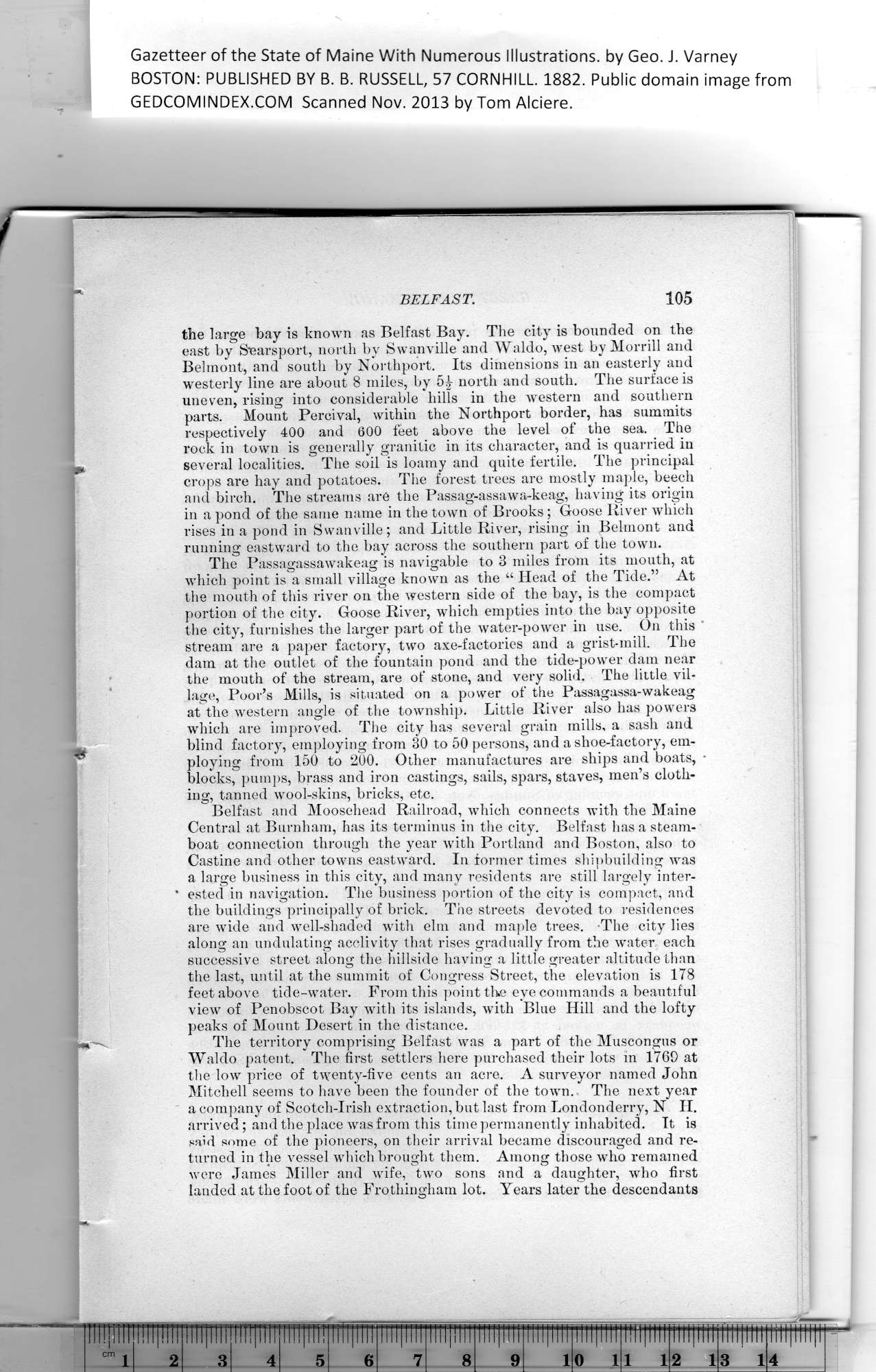|
Gazetteer of the State of Maine With Numerous Illustrations, by Geo. J. Varney
BOSTON: PUBLISHED BY B. B. RUSSELL, 57 CORNHILL. 1882. Public domain image from
BELFAST. 105
the large bay is known as Belfast Bay. The city is bounded on the
east by Svarsport, north by Swanville and Waldo, west by Morrill and
Belmont, and south by Northport. Its dimensions in an easterly and
westerly line are about 8 miles, by 5|- north and south. The surface is
uneven, rising into considerable hills in the western and southern
parts. Mount Percival, within the Northport border, has summits
respectively 400 and 600 feet above the level of the sea. The
rock in town is generally granitic in its character, and is quarried in
several localities. The soil is loamy and quite fertile. The principal
crops are hay and potatoes. The forest trees are mostly maple, beech
and birch. The streams are the Passag-assawTa-keag, having its origin
in a pond of the same name in the town of Brooks; Goose River which
rises in a pond in Swanville; and Little River, rising in Belmont and
running eastward to the bay across the southern part of the town.
The Passagassawakeag is navigable to 3 miles from its mouth, at
which point is a small village known as the “ Head of the Tide.” At
the mouth of this river on the western side of the bay, is the compact
portion of the city. Goose River, which empties into the bay opposite
the city, furnishes the larger part of the water-power in use. On this
stream are a paper factory, two axe-factories and a grist-mill. The
dam at the outlet of the fountain pond and the tide-povver dam near
the mouth of the stream, are of stone, and very solid. The little vil-
lage, Poor’s Mills, is situated on a power of the Passagassa-wakeag
at the western angle of the township. Little River also has powers
which are improved. The city has several grain mills, a sash and
blind factory, employing from 30 to 50 persons, and a shoe-factory, em-
ploying from 150 to 200. Other manufactures are ships and boats,
blocks, pumps, brass and iron castings, sails, spars, staves, men’s cloth-
ing, tanned wool-skins, bricks, etc.
Belfast and Moosehead Railroad, which connects with the Maine
Central at Burnham, has its terminus in the city. Belfast has a steam-
boat connection through the year with Portland and Boston, also to
Castine and other towns eastward. In former times shipbuilding was
a large business in this city, and many residents are still largely inter-
ested in navigation. The business portion of the city is compact, and
the buildings principally of brick. The streets devoted to residences
are wide and well-shaded with elm and maple trees. The city lies
along an undulating acclivity that rises gradually from the water, each
successive street along the hillside having a little greater altitude than
the last, until at the summit of Congress Street, the elevation is 178
feet above tide-water. From this point the eye commands a beautiful
view of Penobscot Bay with its islands, with Blue Hill and the lofty
peaks of Mount Desert in the distance.
The territory comprising Belfast was a part of the Muscongus or
Waldo patent. The first settlers here purchased their lots in 1769 at
the low price of twenty-five cents an acre. A surveyor named John
Mitchell seems to have been the founder of the town. The next year
a company of Scotch-Irish extraction, but last from Londonderry, N H.
arrived; and the place was from this time permanently inhabited. It is
said some of the pioneers, on their arrival became discouraged and re-
turned in the vessel which brought them. Among those who remained
were James Miller and wife, two sons and a daughter, who first
landed at the foot of the Frothingham lot. Years later the descendants
TTITpTffTTf ITfTThT f] 11 ItTttttfrtttrtl ItpTTlTTTTIi I Ittfftft
PREVIOUS PAGE ... NEXT PAGE
This page was written in HTML using a program written in Python 3.2
|
